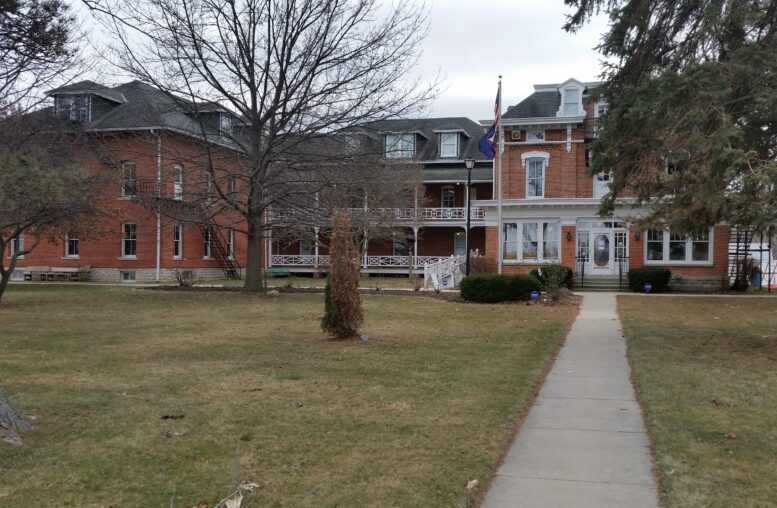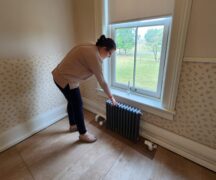(Written by Geoffrey C. Howes of the Historic Preservation Commission)
The old county home and infirmary is Bowling Green’s Historic Building of the Month for March.
Built in 1868 and expanded and partly rebuilt in the 1870s, 1880s and 1890s, the stately brick building at 13660 County Home Road served as the Wood County Home and Infirmary until 1971. In 1975, the Wood County Museum opened in the renovated building.
The structure was listed on the National Register of Historic Places in 1979. One member of the review panel noted: “This resource is significant as one of the few remaining intact examples of the ‘county home’ system once common throughout the state.”
In 1816, just 13 years after Ohio became a state, the General Assembly authorized county commissioners to build “poor houses” or “poor farms” for the indigent. Soon these institutions also housed those who were physically unable to care for themselves – the elderly, the disabled and the chronically ill – and so after 1851 they were called “infirmaries.” After 1919, out of concern for public perceptions of charity, they were more neutrally named “county homes.”
The Ohio State Board of Charities (OSBC) was established in 1867 to investigate and report on the conditions in county infirmaries. The OSBC sent representatives to inspect each site and recommend improvements. Their purpose was to create a uniform system of charity throughout the state. As the first annual report of the OSBC stated: “To meet this responsibility, two things, at least, are essential, and should be uniform: the comfort of those to whom the charities are extended and the convenience of those immediately charged with the dispensation of public charities.”
Accordingly, in October 1867, Wood County bought 160 acres of farmland in Center Township to be used for the “county poorhouse.” In March 1868, the county commissioners appointed J. B. Lockhard as the first infirmary director. On Dec. 1, 1868, the local builder A. Ordway completed the first building (now the west wing), which shows a strong Italianate influence. On Jan. 16, 1869, the Wood County Infirmary opened with six residents.
An attic was added to this oldest building in 1873. In the early 1880s, a central and an east wing were added but were later deemed unsafe. They were demolished and replaced in 1898 by the current central and east wings. A two-story wooden porch with railings in unique geometric designs (now featured on the Wood County Museum’s logo) was built onto the central and east wings. In 1903, a glass-enclosed porch, now the main entrance to the museum, was added to the west wing.
By 1877 there were 65 inmates, and the infirmary had become self-sufficient, with dormitories, a tool house, a chicken coop, outhouses, a woodshed, a cemetery, farm fields, a hog pen, an icehouse, a cattle barn, and a power plant. A reservoir was built in 1886 and another added in 1942. In 1892, the largest cattle barn in Wood County was built on the grounds. It burned down in 1965 and was replaced by a smaller park shelter in 1976.
The nomination form for the listing on the National Register states that the complex was “a model institution in its day,” and is architecturally significant “because the center and eastern sections of the main building were designed by Edward O. Fallis, Toledo architect who was the father of the ‘cottage’ system county home and/or state hospital. Also, the buildings, though relatively simple, represent an unusual, integrated variance of style and function.”
The first superintendent was Thomas C. Reid , succeeded in 1874 by E.M. Jenkins. In 1878 Edwin and Charlotte Farmer assumed the post. They raised their four children at the infirmary, one of whom, Lottie, took over as matron when her father died in 1904.
Lottie and her husband, Superintendent Frank Brandeberry, served until 1949. Frank Brandeberry built the distinctive stone wall and concrete picket fence around much of the grounds, known as “Brandeberry’s Wall.”
Other superintendents and matrons were Dr. Charles and Ruby Petteys (1949-1952), Gene and Mildred Roe (1952-1969), and Nursing Supervisor Doris Roof (1969-1971).
In 1885, the so-called Lunatic House (in the nomenclature of the times), also known as the “jail,” was built east of the main building to house mentally ill inmates. It is cited in the Register of Historic Places as a brick, vernacular Greek revival structure.
In 1900, an Ohio law directed that mentally ill patients be moved to state-run “insane asylums.” Nonetheless, the Lunatic House still accommodated the mentally ill as late as 1925. During the Great Depression, it accommodated members of the general population of the County Home, which swelled to 144. Extensive renovation of the Lunatic House started in 2000 and in 2004 it was reopened with an exhibit about the local and national history of mental health care.
When the Wood County Home closed in 1971, residents were moved to the new Wood County Nursing Home, now Wood Haven Health Care. The county commissioners were persuaded to save the complex, and on Sept. 12, 1976, the Wood County Historical Society opened the remaining 50 acres of infirmary land as the Wood County Historical Center & Museum. The grounds are managed by the Wood County Park District. Today the site is known as the Wood County Museum.
Residents of Bowling Green and Wood County are lucky to have an excellent local history museum that is itself one of its historical displays, as well as a great example of historic preservation.
If you want to learn more about county infirmaries in Ohio, you should visit the Wood County Museum and its award-winning exhibit “FOR COMFORT & CONVENIENCE: Public Charity in Ohio by Way of the Poor Farm.” And read the new book based on the exhibit by the museum’s curator Holly Hartlerode Kirkendall, Ohio’s Infirmary Buildings.
The Wood County Museum is open Monday-Friday 10 a.m. to 4 p.m. and Saturday 12 to 4 p.m. The grounds are a public park, open daily from 8 a.m. until 30 minutes past sunset. Visit https://woodcountyhistory.org for more information.
Would you like to nominate a historic building or site for recognition? You can do this through the city website at – https://www.bgohio.org/FormCenter/Planning-13/Historic-BuildingSite-Nomination-Form-83.
You can learn more about the Historic Preservation Commission by attending their meetings (the fourth Tuesday of each month at 4 p.m.) or by visiting their webpage at – https://www.bgohio.org/436/Historic-Preservation-Commission.
(Howes was assisted in writing this by Curator Holly Kirkendall and Marketing and Events Coordinator Marissa Kolhoff of the Wood County Museum.)





